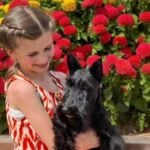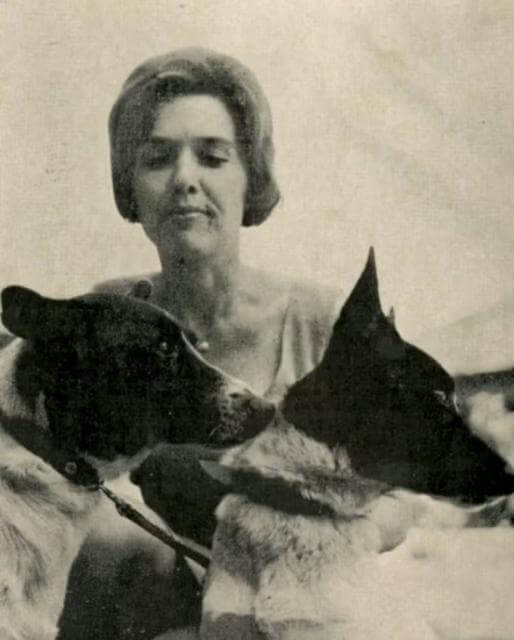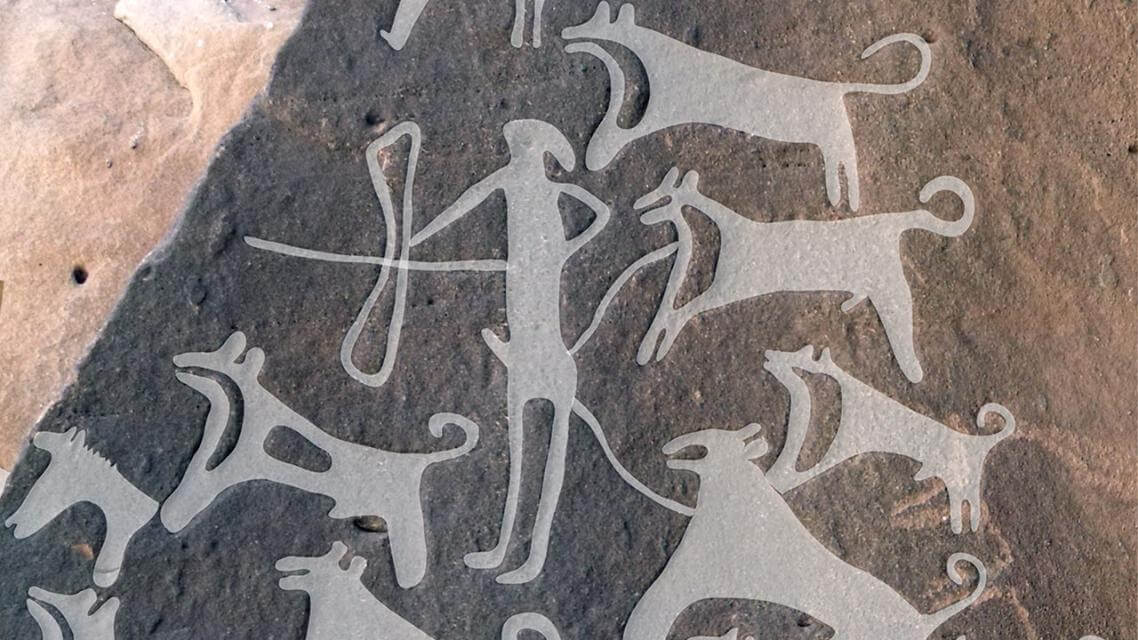
Home » The 9,000-Year-Old Dog – And Why That Matters

Outlines of humans and dogs were carved long ago into the rock of a sandstone cliff. The humans and dogs appear to be hunting lions and other animals, and there are lines running from some of the humans to some of the dogs that look like leashes. We had a photo of this rock art printed on a two-foot by three-foot banner with the caption: “The 9,000-Year-Old Dog.” We often display the banner at Meet the Breeds, judges’ education, and similar events. But what does it mean? It isn’t, as some have joked, a reference to the veteran status of the actual Canaan Dogs attending these events. It is instead a reference to the rich and very ancient history of the breed.

The modern Canaan Dog was domesticated, or more accurately, redomesticated, by Dr. Rudophina Menzel, a well-known cynologist and the founder of the modern Canaan Dog breed. Dr. Menzel had studied the landrace of semi-wild Middle Eastern pariah dogs for years before immigrating to Palestine from Austria in the late 1930s. Upon her arrival, she began training working dogs for the forerunner of today’s Israel Defense Forces. After her own breed, Boxers, struggled in the harsh desert environment, she thought of the semi-wild dogs that thrived in the region, often living around and acting as sentry dogs for the indigenous nomadic Bedouins.
After months of patient effort, she captured one of those dogs, “Dugma” (“Example” in English), who was destined to be the first “Kelev K’naani” or “Canaan Dog” as she named the breed. Dr. Menzel went on to write the first Breed Standard and establish the first breeding program for Canaan Dogs as part of her B’nei Habitachon (“Children of Security”) kennel. She also continued to collect puppies from the semi-wild dogs that lived in the region, as they had for centuries, to add to her breeding and training programs. Dr. Menzel was instrumental in having the Canaan Dog breed recognized first by the Israeli Kennel Club in 1953 and then the Fédération Cynologique Internationale in 1966. In 1965, Dr. Menzel sent four Canaan Dogs to the US, and the breed was fully recognized by the American Kennel Club (AKC) a little over three decades later in 1997.

But what does this have to do with the depiction of The 9,000-Year-Old Dog? It turns out that Dr. Menzel wasn’t the first human to domesticate Canaan Dogs. The breed had lived in close contact with humans in that region for thousands of years. Several genetic studies have found the Canaan Dog to be among the most ancient of breeds. (See, for example, B.M. vonHoldt et. al., Genome-wide SNP and haplotype analysis reveal a rich history underlying dog domestication, Nature 464, 898-902 (2010).) Tomb paintings from the Beni Hasan cemetery in Egypt dating from the 21st to 17th centuries BCE show dogs that look remarkably like Canaan Dogs. (I. Rosellini, Hunters and dogs, from tombs of Beni Hasan 1832-1844.) In addition, at least 1,000 dogs, many of whom have similarities to Canaan Dogs, were buried over 2,300 years ago at the dog cemetery in Ashkelon, Israel. (L.E. Stager, Why Were Hundreds of Dogs Buried at Ashkelon? Biblical Archaeology Review 17/3: 26-42.)
But then, in 2018, a paper was published that indicated that the Canaan Dog breed was much, much more ancient. A group of archaeologists who had been studying rock carvings on the sandstone cliffs of Shuwaymis and Jubbah in northwestern Saudi Arabia published Pre-Neolithic evidence for dog-assisted hunting strategies in Arabia. (M. Guagin et. al., Journal of Anthropological Archaeology 2018.) The paper describes 179 rock art panels of domesticated dogs and humans hunting a variety of animals from equines to ungulates, to even leopards and lions. Many of the almost 350 dogs illustrated are leashed to human hunters.

The paper then described the dogs: “[A]ll of the dogs display characteristic pricked ears, short snouts, deeply-angled chests, and a curled tail, appearing to be of the same ‘type.’… [W]e suggest these canids bear a close resemblance to the modern Canaan Dog.” The paper further described how “some of the depicted dogs appear to have spots or ‘ticks’ on their coats,” while others have “white patches on the front of the chest, forehead, or lower legs,” all “similar to modern Canaan dogs.”
The archaeologists then dropped their bombshell: The rock carvings were approximately 9,000 years old, making them the earliest portrayals of domesticated dogs ever found. They then reiterated that the dogs’ “phenotypic traits such as pricked ears, curled tails and coat patterning… bear a remarkable resemblance to the modern Canaan Dog, a breed associated with the Levant, but which may have a more ancient ancestry than previously assumed.” Thus, the Canaan Dog is very probably The 9,000-Year-Old Dog.
While this may all be interesting to history buffs, it is also important for anyone involved with Canaan Dogs, from breeders to exhibitors to judges, because this 9,000-year history informs almost every aspect and characteristic of the breed. For millennia, Canaan Dogs have lived in and adapted to their harsh environment, and that history should be evidenced in the breed today.
The most-used word, in various iterations, in the AKC Breed Standard is “moderate.” For example, the Standard provides that the Canaan Dog is a “square dog of medium size, moderate and balanced without extremes, showing a clean outline.” That is because dogs that were not moderate and balanced, such as those with extreme angulation, simply would not have survived in the desert.
Canaan Dogs should “move[] with athletic agility and grace in an efficient, ground-covering endurance trot.” That is because they had to efficiently cover large distances searching for food and following the nomadic people they lived among. Moderate angulation should “result[] in the appropriate reach and drive of the natural dog’s endurance trot.” That means no inefficient hackneying, nor energy-sapping sprinting around a show ring.

Canaan Dogs should have “a straight, harsh, flat-lying double coat.” Just like the indigenous humans of the area, they needed to cover up to protect against the strong desert sun and the cold desert nights. And given their 9,000-year history of living around and with humans, first as hunting companions and later primarily as sentry dogs, the Canaan Dog should be “naturally alert, inquisitive and watchful. He is mistrustful of strangers and unfamiliar environments, yet loyal and loving with his family.”
So, if you witness a Canaan Dog stopping and looking around halfway through his down and back in the show ring, or in the middle of a set of weave poles, when someone drops a wire crate next to the ring, he is doing exactly what he’s spent 9,000 years training to do.